The Huntington’s blog takes you behind the scenes for a scholarly view of the collections.
Silver Bird
Posted on Thu., Aug. 18, 2016 by
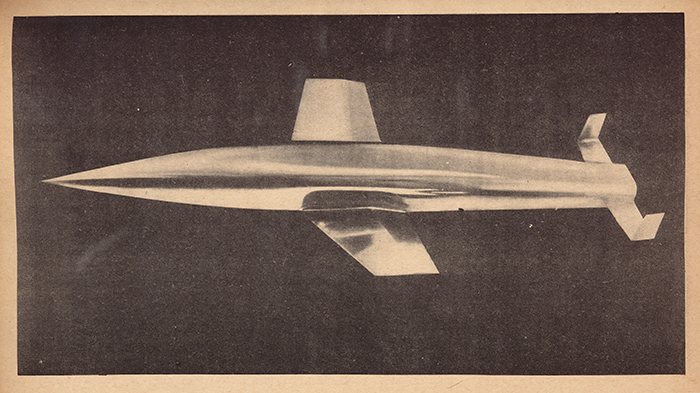
Outside form of an intercontinental super bomber proposed in Über einen Raketenantrieb für Fernbomber (A Rocket Drive for Long-Range Bombers) by Eugen Sänger, an Austrian aeronautical engineer who—along with his partner (and later, wife) Irene Bredt—developed the concept during World War II. The Huntington Library, Art Collections, and Botanical Gardens.
I’m a history professor doing research on how the detritus left behind by the space race informs the global circulation of knowledge in the modern era. One of the things I love about academic exploration is not knowing what I’ll uncover. So when I arrived at The Huntington as the Eleanor Searle Visiting Professor in the History of Science and Technology, I was hoping for a few surprises.
Little did I imagine, however, that I’d unearth an original copy of a report about a Nazi-era secret weapon that could skirt the very reaches of space as it flew from Europe to North America. Yet there it was: Über einen Raketenantrieb für Fernbomber (A Rocket Drive for Long-Range Bombers) by an Austrian aeronautical engineer by the name of Eugen Sänger (1905–1964). I was able to piece together the story of this intercontinental super bomber by delving into Sänger’s papers, which are spread across several collections at The Huntington.
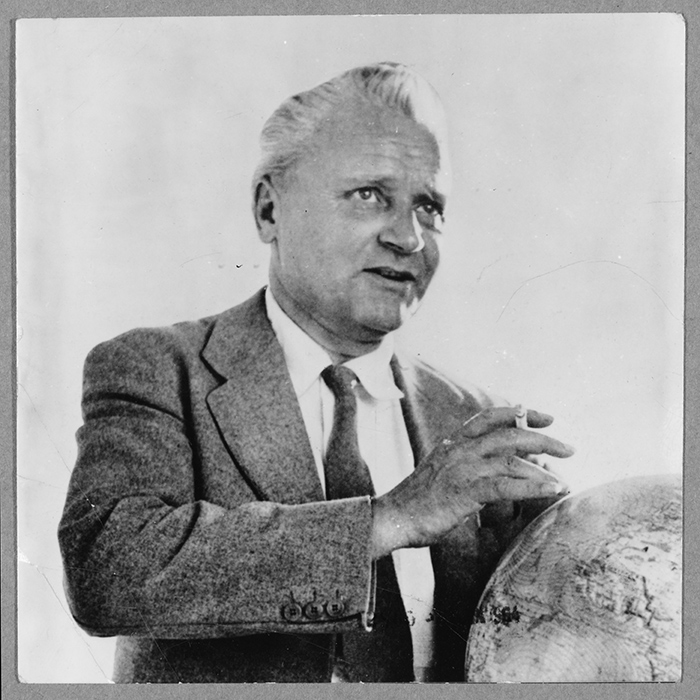
Eugen Sänger (1905–1964), Theodore von Kármán Collection, The Huntington Library, Art Collections, and Botanical Gardens.
Sänger developed the concept in collaboration with his partner (and later, wife) Irene Bredt to satisfy Nazi interest in obtaining a weapon with which to attack the contiguous United States. Sänger was a member of both the Nazi Party and the SS, and in 1944, he drew up a formal proposal and sent it to the Reich’s Air Ministry. Although some Nazi officials believed they could build such a bomber, which Sänger called Silbervogel, or Silver Bird, the end of the war interceded and the idea remained largely on paper.
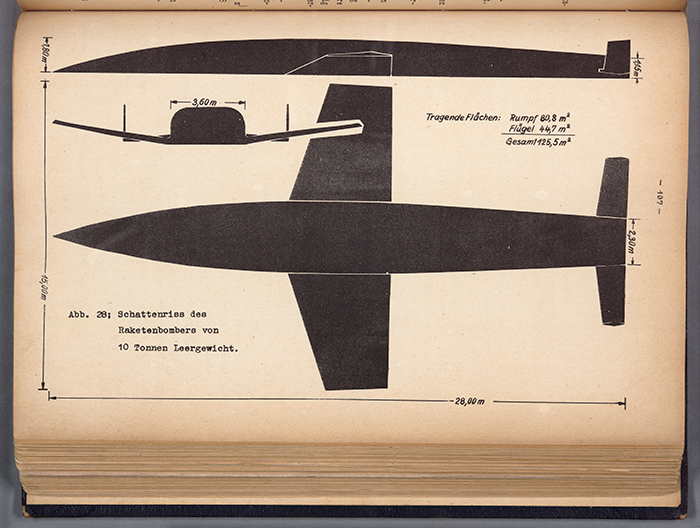
Silhouette of the bomber that Sänger called Silbervogel, or Silver Bird, from Über einen Raketenantrieb für Fernbomber (A Rocket Drive for Long-Range Bombers). The Huntington Library, Art Collections, and Botanical Gardens.
Yet rumors of the Silver Bird had spread among Allied intelligence. In the chaos of war’s end and in the midst of the plunder of German industry, both American and Soviet officials urgently sought copies of Sänger and Bredt’s report—estimated to number only 100 copies. A Soviet official apparently stumbled upon the document—stamped Streng Geheim (top secret)—while relieving himself behind a woodpile at Peenemünde, the secret German rocket center on the Baltic Sea coast. The Soviets were amazed at the level of specificity in the proposal: Sänger and Bredt had considered every arcane technical detail of flying a piloted rocket ship at 30,000 kilometers per hour—fast enough to send the plane into orbit around the Earth.
The Soviet military immediately translated the report and issued a slim edition circulated among key officials and scientists. Eventually word got to Joseph Stalin, perhaps through Stalin’s son Vasili, who was an air force pilot. Around that time, Stalin found out that Sänger himself was in postwar Germany, providing a tantalizing opportunity to implement the project under its author. Russian archival revelations suggest that Stalin orchestrated a kidnapping attempt, which failed, to bring Sänger to the Soviet Union.
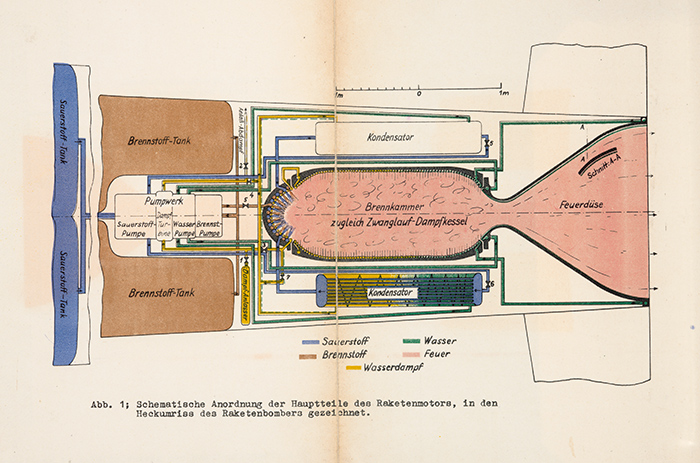
Illustration of the rocket motor for Sänger and Bredt’s proposed long-range bomber in Über einen Raketenantrieb für Fernbomber (A Rocket Drive for Long-Range Bombers). The Huntington Library, Art Collections, and Botanical Gardens.
The Silver Bird was never built, being far too ahead of its time. For many years, Soviet scientists and engineers invested resources in building the engine that would power the Silver Bird but eventually abandoned even that line of work around 1950. Some have argued that Sänger-Bredt’s bomber cast a long shadow across the future of space exploration, having essentially anticipated many of the technical innovations that allowed NASA to fly the Space Shuttle into orbit.
Among my findings was Sänger’s personal copy of the Silver Bird report from 1944, which resides in The Huntington’s rare books collection. The volume was probably obtained by Theodore von Kármán, one of the founders of the Jet Propulsion Laboratory, and then passed on to Jeremy Norman, a collector of rare books on the history of science, who donated it to The Huntington in 2015.
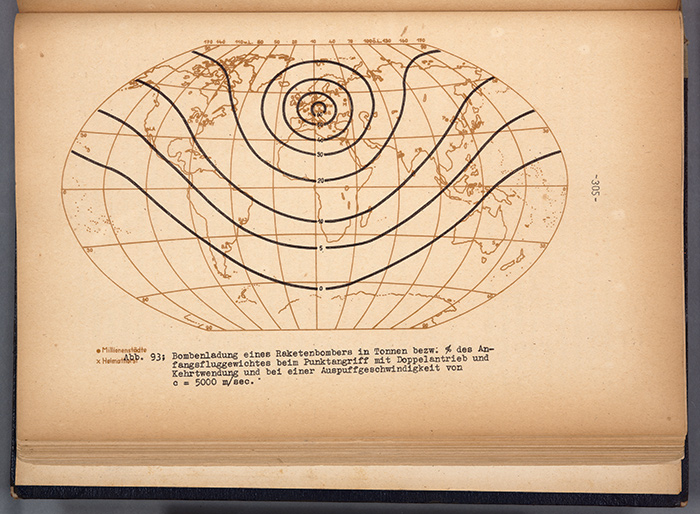
Global map indicating the theoretical maximum range of the proposed bomber Silbervogel, or Silver Bird, from Über einen Raketenantrieb für Fernbomber (A Rocket Drive for Long-Range Bombers). The Huntington Library, Art Collections, and Botanical Gardens.
The report is beautifully illustrated and annotated with handwritten marginalia in pencil at different points, suggesting that Sänger saw it as a basis for further discussion. Although the tone of the report is highly technical, the subtext is clear: the Silver Bird would fly across the world for one mission and one mission only: to bomb the enemy. The target was the United States—more specifically, New York City. Among the pages of the report are several maps of that city with circles marking Manhattan.
The maps underscore so vividly how the line between scientific research and military imperative was a nebulous one, especially during World War II and the ensuing Cold War. For me, it was one more bit of evidence that the space race was more complicated and stranger than we typically believe—filled with details that are unexpected, sometimes terrifying in their scope, and capable of altering our perspective on the past.
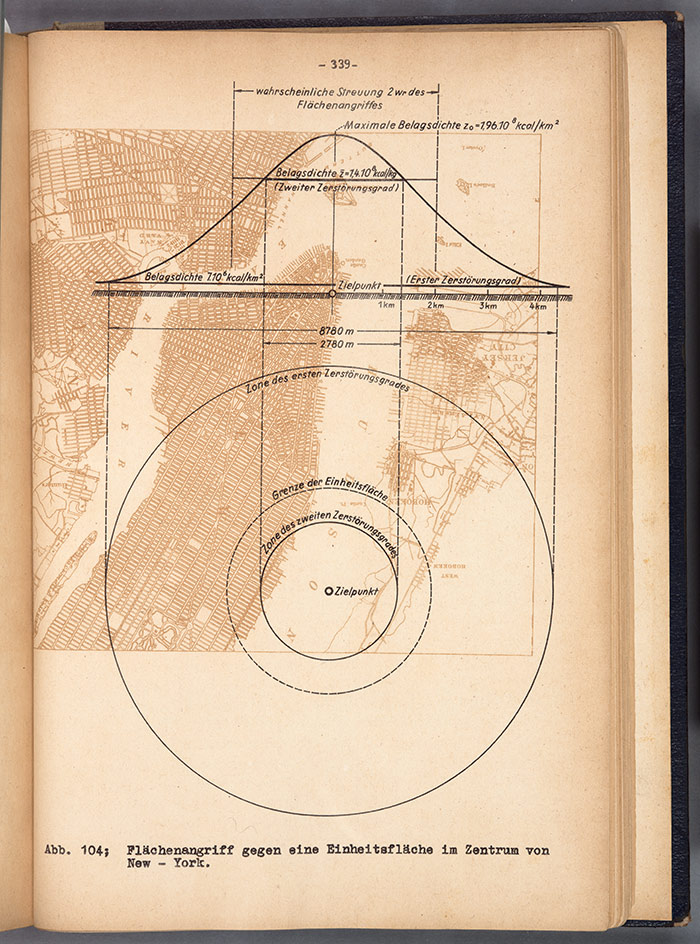
Map of New York City as a bombing target for the Silver Bird in Über einen Raketenantrieb für Fernbomber (A Rocket Drive for Long-Range Bombers). The Huntington Library, Art Collections, and Botanical Gardens.
Asif Siddiqi is professor of history at Fordham University and was the 2015–16 Eleanor Searle Visiting Professor in the History of Science and Technology at Caltech and The Huntington. His books include The Red Rockets’ Glare: Spaceflight and the Russian Imagination, 1857–1957, Sputnik and the Soviet Space Challenge, and The Soviet Space Race with Apollo.